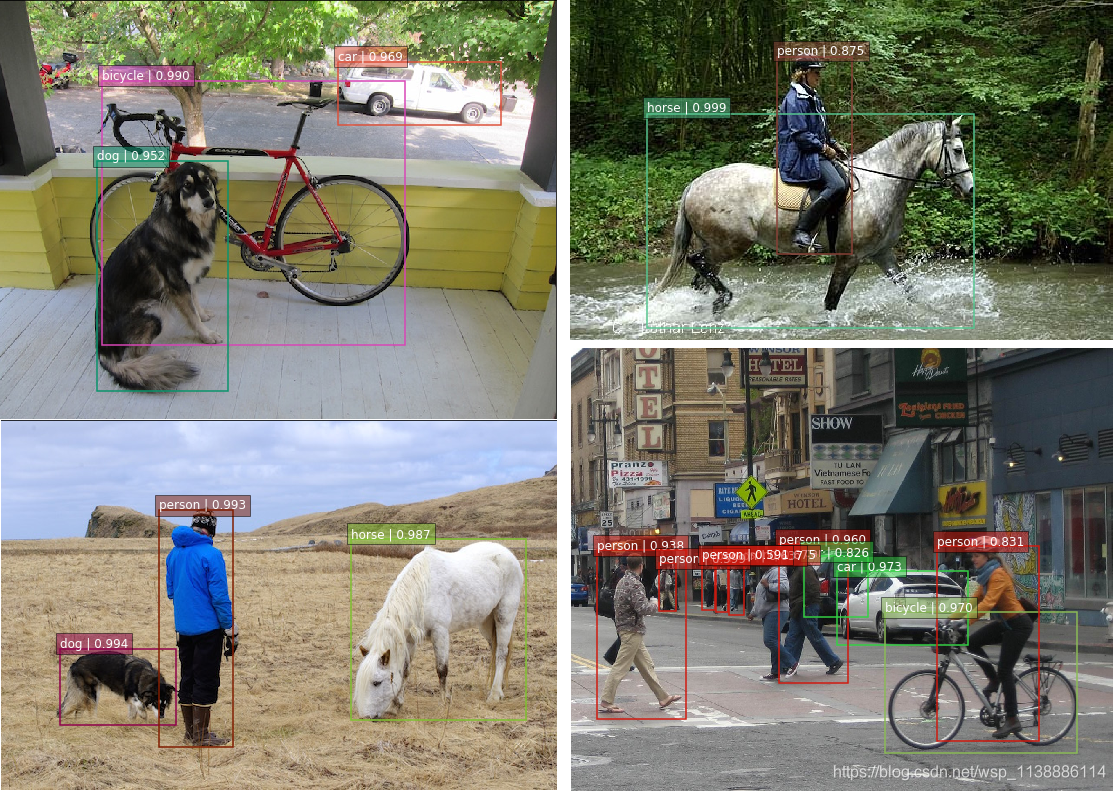版权声明:转载请说明来源,谢谢 https://blog.csdn.net/wsp_1138886114/article/details/85409661
各位好,今天主要讲解基于目标检测的图像分类,之前在做图像分类的模型时,分类准确度始终是个问题。特别是在公司做项目时,要对图像内容进行识别,图像样式近200多种,由于图像数据是经过扫描+压缩过的图像,图像质量可想而知,在对其进行识别时,困难十分大,故要对其分类,在针对不同模板类分别识别,提高准确率。所以想到做基于检测的图像分类,还好,想到了这个方法,前期的数据处理把我累的。不过,分类准确率直线上升。今天为大家带来VOC2007数据集的分类。
关于数据集的标注,模型训练。我这里不在论述。直接进行预测分类
一、准备
我这里为方便观察,修改了SSD-Tensorflow/notebooks/visualization.py预测代码。
修改后代码如下:
# Copyright 2017 Paul Balanca. All Rights Reserved.
#
# Licensed under the Apache License, Version 2.0 (the "License");
# you may not use this file except in compliance with the License.
# You may obtain a copy of the License at
#
# http://www.apache.org/licenses/LICENSE-2.0
#
# Unless required by applicable law or agreed to in writing, software
# distributed under the License is distributed on an "AS IS" BASIS,
# WITHOUT WARRANTIES OR CONDITIONS OF ANY KIND, either express or implied.
# See the License for the specific language governing permissions and
# limitations under the License.
# ==============================================================================
import cv2,sys
import random
import matplotlib.pyplot as plt
import matplotlib.image as mpimg
import matplotlib.cm as mpcm
# =========================================================================== #
# Some colormaps.
# =========================================================================== #
def colors_subselect(colors, num_classes=21):
dt = len(colors) // num_classes
sub_colors = []
for i in range(num_classes):
color = colors[i*dt]
if isinstance(color[0], float):
sub_colors.append([int(c * 255) for c in color])
else:
sub_colors.append([c for c in color])
return sub_colors
colors_plasma = colors_subselect(mpcm.plasma.colors, num_classes=21)
colors_tableau = [(255, 255, 255), (31, 119, 180), (174, 199, 232), (255, 127, 14), (255, 187, 120),
(44, 160, 44), (152, 223, 138), (214, 39, 40), (255, 152, 150),
(148, 103, 189), (197, 176, 213), (140, 86, 75), (196, 156, 148),
(227, 119, 194), (247, 182, 210), (127, 127, 127), (199, 199, 199),
(188, 189, 34), (219, 219, 141), (23, 190, 207), (158, 218, 229)]
# =========================================================================== #
# OpenCV drawing.
# =========================================================================== #
def draw_lines(img, lines, color=[255, 0, 0], thickness=2):
"""Draw a collection of lines on an image.
"""
for line in lines:
for x1, y1, x2, y2 in line:
cv2.line(img, (x1, y1), (x2, y2), color, thickness)
def draw_rectangle(img, p1, p2, color=[255, 0, 0], thickness=2):
cv2.rectangle(img, p1[::-1], p2[::-1], color, thickness)
def draw_bbox(img, bbox, shape, label, color=[255, 0, 0], thickness=2):
p1 = (int(bbox[0] * shape[0]), int(bbox[1] * shape[1]))
p2 = (int(bbox[2] * shape[0]), int(bbox[3] * shape[1]))
cv2.rectangle(img, p1[::-1], p2[::-1], color, thickness)
p1 = (p1[0]+15, p1[1])
cv2.putText(img, str(label), p1[::-1], cv2.FONT_HERSHEY_DUPLEX, 0.5, color, 1)
def bboxes_draw_on_img(img, classes, scores, bboxes, colors, thickness=2):
shape = img.shape
for i in range(bboxes.shape[0]):
bbox = bboxes[i]
color = colors[classes[i]]
# Draw bounding box...
p1 = (int(bbox[0] * shape[0]), int(bbox[1] * shape[1]))
p2 = (int(bbox[2] * shape[0]), int(bbox[3] * shape[1]))
cv2.rectangle(img, p1[::-1], p2[::-1], color, thickness)
# Draw text...
s = '%s/%.3f' % (classes[i], scores[i])
p1 = (p1[0]-5, p1[1])
cv2.putText(img, s, p1[::-1], cv2.FONT_HERSHEY_DUPLEX, 0.4, color, 1)
# =========================================================================== #
# Matplotlib show...
# =========================================================================== #
def plt_bboxes(img, classes, scores, bboxes, figsize=(10,10), linewidth=1.5):
"""Visualize bounding boxes. Largely inspired by SSD-MXNET!
"""
# ===================adde-start ======================
def num2class(n):
sys.path.append('../')
from datasets import pascalvoc_2007 as pas
x=pas.pascalvoc_common.VOC_LABELS.items()
for name,item in x:
if n in item:
return name
# ===================added-end======================
fig = plt.figure(figsize=figsize)
plt.imshow(img)
height = img.shape[0]
width = img.shape[1]
colors = dict()
class_names = [] # 用来储存类别名(一张图有可能不只一个类别名)
for i in range(classes.shape[0]):
cls_id = int(classes[i])
if cls_id >= 0:
score = scores[i]
if cls_id not in colors:
colors[cls_id] = (random.random(), random.random(), random.random())
ymin = int(bboxes[i, 0] * height)
xmin = int(bboxes[i, 1] * width)
ymax = int(bboxes[i, 2] * height)
xmax = int(bboxes[i, 3] * width)
rect = plt.Rectangle((xmin, ymin), xmax - xmin,
ymax - ymin, fill=False,
edgecolor=colors[cls_id],
linewidth=linewidth)
plt.gca().add_patch(rect)
#================adde-start ==============
class_name = num2class(cls_id)
class_names.append(class_name)
#================added-end=================
plt.gca().text(xmin, ymin - 2,
'{:s} | {:.3f}'.format(class_name, score),
bbox=dict(facecolor=colors[cls_id], alpha=0.5),
fontsize=12, color='white')
plt.show()
return class_names

二、加载模型预测分类
在SSD-Tensorflow\notebooks目录下打开jupyter notebook(注意运行环境),打开ssd_notebook.ipynb文件,修改最后一个cell 代码如下:
依次运行所有cell即可。
# Test on some demo image and visualize output.
import shutil
path = '../demo/'
image_names = sorted(os.listdir(path)) # 获取测试文件夹所有图片
for it in image_names:
img = mpimg.imread(path + it)
print("path + it",path + it)
rclasses, rscores, rbboxes = process_image(img)
class_names = visualization.plt_bboxes(img, rclasses, rscores, rbboxes)
if "person" in class_names: # 将有人的图片复制到目标目录
shutil.copy(path + it,"D:/person/person_00"+it[-8:])
else:
pass
三、生成 .tfrecords文件,批量测试
关于数据集的下载,详情请点击
在工程目录下下创建文件夹(可省略)用来放置测试文件。文件格式与训练集相同。
- 打开
tf_convert_data.py文件,
依次点击:run , Edit Configuration,在面板中依次执行如下:
Name:tf_convert_data
Script path :D:\XXX\SSD-Tensorflow\tf_convert_data.py最好是绝对路径
在Parameters中填入以下内容: 设置好点击Apply,OK。执行。
--dataset_name=pascalvoc
--dataset_dir=./VOC2007_test/
--output_name=voc_2007_test
--output_dir=./tfrecords_test
